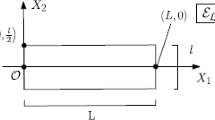Abstract:
If a pair of material line elements, passing through a typical particle P in a body, subtend an angle Θ before deformation, and Θ+γ after deformation, the pair of material elements is said to be sheared by the amount γ. Here all pairs of material elements at P are considered for arbitrary deformations. Two main problems are addressed and solved. The first is the determination of all pairs of material line elements at P which are unsheared. The second is the determination of that pair of material line elements at P which suffers the maximum shear.
All unsheared pairs of material elements in a given plane π(S) with normal S passing through P are considered. Provided π(S) is not a plane of central circular section of the C-ellipsoid at P (where C is the right Cauchy-Green strain tensor), it is seen that corresponding to any material element in π(S) there is, in general, one companion material element in π(S) such that the element and its companion are unsheared.
There are, however, two elements in π(S) which have no companions. We call their corresponding directions \textit{limiting directions.} Equally inclined to the direction of least stretch in the plane π(S), the limiting directions play a central role. It is seen that, in a given plane π(S), the pair of material line elements which suffer the maximum shear lie along the limiting directions in π(S). If Θ L is the acute angle subtended by the limitig directions in π(S) before deformation, then this angle is sheared into its supplement π−Θ L so that the maximum shear γ*;(S) is γ*=π− 2 Θ L . If S is given and C is known, then Θ L may be determined immediately. Its calculation does not involve knowing the eigenvectors or eigenvalues of C.
When all possible planes through P are considered, it is seen that the global maximum shear γ* G occurs for material elements lying along the limiting directions in the plane spanned by the eigenvectors of C corresponding to the greatest principal stretch λ3 and the least λ1. The limiting directions in this principal plane of C subtend the angle and . Generally the maximum shear does not occur for a pair of material elements which are originally orthogonal.
For a given material element along the unit vector N, there is, in general, in each plane π(S passing through N at P, a companion vector M such that material elements along N and M are unsheared. A formula, originally due to Joly (1905), is presented for M in terms of N and S.
Given an unsheared pair π(S), the limiting directions in π(S) are seen to be easily determined, either analytically or geometrically.
Planar shear, the change in the angle between the normals of a pair of material planar elements at X, is also considered. The theory of planar shear runs parallel to the theory of shear of material line elements. Corresponding results are presented.
Finally, another concept of shear used in the geology literature, and apparently due to Jaeger, is considered. The connection is shown between Cauchy shear, the change in the angle of a pair of material elements, and the Jaeger shear, the change in the angle between the normal N to a planar element and a material element along the normal N. Although Jaeger's shear is described in terms of one direction N, it is seen to implicitly include a second material line element orthogonal to N.
Similar content being viewed by others
Author information
Authors and Affiliations
Additional information
Accepted: May 25, 1999
Rights and permissions
About this article
Cite this article
Boulanger, P., Hayes, M. On Finite Shear. Arch. Rational Mech. Anal. 151, 125–185 (2000). https://doi.org/10.1007/s002050050195
Issue Date:
DOI: https://doi.org/10.1007/s002050050195




